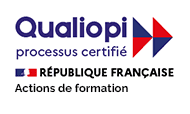Programme Aruba OS-CX Switching Fundamentals
Durée : 5 jours - 35 heures
Tarif : Nous contacter pour une formation INTER – INTRA ou en COURS PARTICULIER
La formation est délivrée en présentiel ou distanciel (e-learning, classe virtuelle, présentiel et à distance). Le formateur alterne entre méthodes démonstrative, interrogative et active (via des travaux pratiques et/ou des mises en situation). La validation des acquis peut se faire via des études de cas, des quiz et/ou une certification.
Cette formation est animée par un consultant-formateur dont les compétences techniques, professionnelles et pédagogiques ont été validées par des diplômes et/ou testées et approuvées par l’éditeur et/ou par Audit Conseil Formation.
Les objectifs


pré-requis
Pour suivre cette formation Aruba Switching, il est recommandé de disposer d'une première expérience (six mois minimum) dans le déploiement de solutions réseau à petite et moyenne échelle.
Moyens pédagogiques, techniques et d'encadrement
- 1 poste de travail complet par personne
- De nombreux exercices d'application
- Mise en place d'ateliers pratiques
- Remise d'un support de cours
- Remise d'une attestation de stage
Modalités d'évaluation des acquis
- Evaluation des besoins et objectifs en pré et post formation
- Evaluation technique des connaissances en pré et post formation
- Evaluation générale du stage
Accessibilité handicapés
- Au centre d’affaires ELITE partenaire d’ACF à 20 m.
- Guide d’accessibilité à l’accueil.
Le Programme
Network Fundamentals
What is a network?
What is a Protocol?
OSI Reference Model
Encapsulation, frames, packets, segments
Layer 2 to Layer 7 headers
Media, cabling, Ethernet/wifi headers
Binary/Hex/Decimal theory and conversion
TCP/IP Stack (IP addressing & Transport Protocols TCP/UDP)
Types of traffic : Unicast, Broadcast, Multicast
TCP/IP Stack
Overview
Ethernet frames
IPv4 Header
TCP Header – Three-way Handshake
TCP Header – Sequence Numbers
TCP Header – Port Numbers
TCP Header
UPD Header
Basic Networking with Aruba Solutions
Networking devices: Switches, Routers, Multilayer
Switches, APs, Mobility Controllers, Firewalls, Servers
(HTTP, DHCP, DNS, Telnet, FTP)
2-Tier vs 3-Tier hierarchy
Switching Portfolio (AOS switches & AOS-CX switches) is this introducing both portfolio on a couple of slide and few slides on AOS-CX hardware architecture, software architecture and intro to NAE high level.
Introduction to AOS-CX and feature set
Port numbering
Accessing Aruba OS-CX CLI
Prompt modes/levels and navigation
Context sensitive help
Show logs, configuration, interfaces, transceivers, flash,
version
Hostname/interface name, enabling interfaces
Link Layer Discovery Protocol
ICMP and reachability testing tools: Ping and
Traceroute
PoE (standards one slide and what we support and one or two slide on configuration and verifications.)
VLANs
Broadcast/collision domains
VLAN benefits
VLAN creation
DHCP server configuration in switches (optional)
802.1Q tagging
Switchports vs. Routed ports
MAC address table
ARP table
Packet Delivery part 1
Spanning Tree Protocol
Redundant network
L2 loops
802.1D
Common Spanning Tree
802.1s
802.1w overview
802.1w load balancing
802.1w region configuration
Link Aggregation
Static Aggregation
LACP
Load Balancing
IP Routing - Part 1
Default Gateway
DHCP IP Helper Address
IP Routing Service
Inter-VLAN routing
Packet Delivery Part 2
Need for layer 3 redundancy
Introduction to VRF
VRRP
VRRP overview
VRRP basic operation
VRRP failover and preempt
VRRP and MSTP coordination
IP Routing - Part 2
Subnetting
CIDR
Static routes
Administrative Distance
Floating routes
Scalability issues
IP Routing - Part 3
IGP vs EGP
Distance Vector vs Link State
OSPF Router-ID and Hello Messages
Passive interfaces
States
DR and BDR
LSDB: LSA 1 and 2
Path selection and convergence
Using cost to manipulate routes
Stacking
Control Plane, Management Plane, and Data Plane
Introduction to Stacking technologies
Stacking Benefits
Centralized control and management plane
Distributed Data Plane and Distributed Link
Aggregation
VSF
VSF requirements
VSF Link and member roles
VSF member IDs and port numbers
VSF Configuration
VSF Provisioning use cases
Tracing Layer 2 traffic: Unicast
Tracing Layer 2 traffic: Broadcast, Multicast, and
Unknown Unicast
VSF Failover and OSFP Graceful-Restart
VSF Link failure without MAD
MAD
VSX Introduction
Secure Management and Maintenance
OOBM port
Management VRF
Secure Management Protocols: AAA, SSH, HTTPS, RBAC
Radius-based management auth (VSA)
SNMP
Web interface
Configuration file management (Backup, restore, checkpoint and roll back)
Operating System image management (backup and restore)
Factory default/password recovery
AOS-CX Management tools
Intro to NetEdit
NetEdit installation
Basic monitoring with NetEdit
AOS-CX Mobile App



